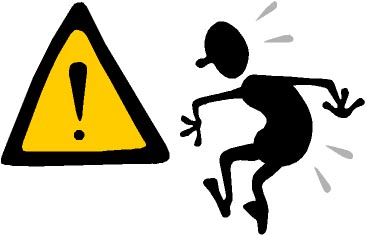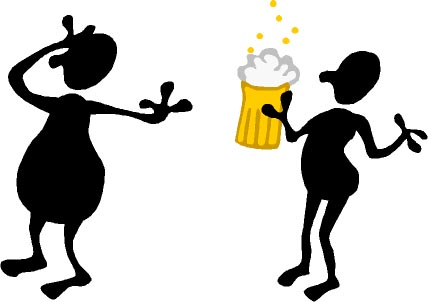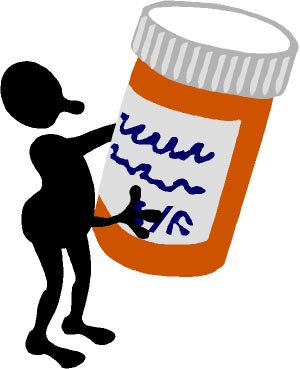ADD
What Are They All About?
***Caution*** This page attempts to simplify a very complex condition. While providing an overview, it lacks detail and depth. The reader is advised to investigate the topic in a more precise and in-depth manner. Does the youngster's attention span remind you of when you push the scan button on your car radio? Is s/he Einstein from the neck up, but Fred Astaire from the neck down? That youngster might have an attention and/or overactivity disorder. School is oftentimes the first place where characteristics of ADD are noted or viewed as problematic. It may be that the school setting is the first place where the youngster is asked to stay seated for long periods of time, maintain extended attention to a live individual, persist on a task, or wait one's turn. "Curious" kids who seem to attend to everything, often become known as "distractible" when they are unable to filter out extraneous sights and noises in the classroom. Youngsters with ADD experience difficulties in the areas necessary for academic success: starting work assignments, completing tasks, interacting cooperatively with others, following directions, making smooth transitions, and managing multi-step tasks. Excessive activity levels, talkativeness, interrupting, fidgeting, active and out of seat behavior, and underdeveloped social skills may also be evident. A number of factors effect performance including time of day, amount of rest or fatigue, adequacy of supervision, adequacy of medication, and so forth. Since Dr. George Still first described "moral turpitude" (lack of moral self control) in 1902, the fields of education and mental health have strived to devise more appropriate names, better categorization systems, more accurate assessment procedures, and more effective teaching strategies. It is one of the areas of greatest contention in the field of special needs. Should these youngsters be labeled as "special ed"? How many kids have these conditions? Do these conditions really exist or are they simply excuses for poor parenting? It all depends on who you listen to. Below is a synopsis of the literature. Diagnosis One caution: Many physicians use their own criteria, failing to fully consider the DSM-5 criteria. Be certain to ask your family physician if the diagnosis was based on the DSM-5 guidelines. Diagnostic procedures that involve brain scans are being tested and studied at present
I was trying to daydream, but my mind kept wandering.
(Depression in Children") can present itself in distractible or active behavior. Depression should be ruled out previous to a diagnosis of ADD or ADHD. How Many Kids Have These Conditions? ADD/ADHD is the most common childhood neurobehavioral disorder and it is estimated that ½ to 2/3 of individuals will carry the condition into adolescence and adulthood, often being viewed by others as "talkative", "scatterbrained", and/or "forgetful". They are also at greater risk for experiencing social ills (i.e., family problems, job difficulties). What Causes ADD/ADHD? -prenatal problems In "true" ADD and ADHD, biochemical reactions related to the brain's neurotransmitters, especially the dopamine and serotonin pathways are involved. Frontal lobes (the brain's center for attention and impulsivity) of ADHD individuals have been found to use less glucose (resulting in less energy) and demonstrate less electrical activity. Treatments for ADD/ADHD Ritalin may be available in a time release form, or the youngster may need to receive the medication every three to four hours. It takes about 30 minutes to take effect. Cylert takes days to weeks to become effective, but thereafter is needed only once per day. A new drug, Concerta (a new form of the drug Methlyphenidate, commonly known as Ritalin) is now available. Unlike Ritalin, which requires two or three doses per day, Concerta lasts 12 hours, making in-school and after-school dosing unnecessary. Concerta comes in tablet form and is taken in the morning before school. Strattera, a non-stimulant medication from Lilly Pharmaceuticals was introduced around 2003. Side effects often accompany the medications. The most common are loss of appetite, weight loss, irritability when the medication wears off, stomach pains, dry mouth, and problems falling asleep. Less common side effects are slowed growth, tic disorders, and problems with flexible thinking. As a teacher who sees the youngster often, you should document any possible side effects and report them to the parents/physician. Medication is not a substitute for therapy and training. It helps kids to better respond to the help. It is estimated that about 90% of youngsters with ADHD benefit from the administration of medication. Should They, or Can They Be Labeled "Special Ed"? (United States Education Law) If symptoms do not meet the criteria of the Individuals with Disabilities Education Act (the special education law), or school personnel hinder IDEA identification, parents sometimes seek to have their child labeled under the less stringent conditions of Section 504 of the Rehabilitation Act of 1973 (as amended). Under section 504, a civil rights act, disabled youngsters are guaranteed school services to meet their needs. A person with a disability is defined as "any person who has a physical or mental impairment which substantially limits a major life activity." Certainly schooling and socializing are major life activities. If the student qualifies for special services under Section 504, the school must make determine and meet the educational needs of that youngster. There is no one test for identifying whether youngsters have ADD or ADHD. While physicians are often involved in the identification procedure, the U.S. Office of Education does NOT require a medical evaluation. However, some states have added the additional requirement of a physician's evaluation. The Professional Group for Attention and Related Disorders (PGARD) recommends a two-tier process of evaluation for identifying ADD and ADHD. The first tier contains a clinical evaluation to determine whether the youngster's symptoms match the criteria listed in DSM-5. The second level is comprised of an educational evaluation to determine if the condition is having a substantial negative impact on academic and classroom performance. All individuals familiar with this youngster should contribute to the process which attempts to identify when the behaviors began, how often and under what circumstances they appear, and the effect on the youngster's academics, psychological state, and social life. It is hoped that this multi-source process will provide an accurate overall picture of the boy/girl, and help in identification and programming. TIME OUT FOR A LITTLE HUMOR: Click here for cartoons about ADD & ADHD
|
||

 Random Thought: Perhaps the ADD part of ADHD isn't really an attentional problem at all. These kids are able to attend to a lot more things than me during a short period of time. Maybe it's best thought of as more of a "filtering" problem... being able to block out stimuli that is unimportant to the task being addressed in the moment.
Random Thought: Perhaps the ADD part of ADHD isn't really an attentional problem at all. These kids are able to attend to a lot more things than me during a short period of time. Maybe it's best thought of as more of a "filtering" problem... being able to block out stimuli that is unimportant to the task being addressed in the moment.


 For pre-adolescents, medications like Ritalin, despite being stimulants, work well (reports vary with 65-90% positive treatment ratings). Known as the "reciprocal effect", it is not known exactly why a stimulant calms these youngsters and helps them to concentrate. Some believe that hyperactive and distractible behavior is an attempt to stimulate an underperforming brain. The stimulant is believed to "speed up" the brain, increasing the level of dopamine in the frontal lobe of the brain which regulates attention and impulsivity, so that it needs less stimulation. In other words, the drugs calm the individual by making the brain work more efficiently. Research indicates that medication does work better than behavior modification therapy, and a combination of the two interventions is NOT more effective than the medication alone (NY Times, page A8, 12/15/99). However, among the 70% of these youngsters who also had depression or anxiety with their condition, the combination did yield significant benefits beyond medication alone. Educational remediation and special education often accompany the medication, as do parent training, family counseling, youth counseling, or other intervention.
For pre-adolescents, medications like Ritalin, despite being stimulants, work well (reports vary with 65-90% positive treatment ratings). Known as the "reciprocal effect", it is not known exactly why a stimulant calms these youngsters and helps them to concentrate. Some believe that hyperactive and distractible behavior is an attempt to stimulate an underperforming brain. The stimulant is believed to "speed up" the brain, increasing the level of dopamine in the frontal lobe of the brain which regulates attention and impulsivity, so that it needs less stimulation. In other words, the drugs calm the individual by making the brain work more efficiently. Research indicates that medication does work better than behavior modification therapy, and a combination of the two interventions is NOT more effective than the medication alone (NY Times, page A8, 12/15/99). However, among the 70% of these youngsters who also had depression or anxiety with their condition, the combination did yield significant benefits beyond medication alone. Educational remediation and special education often accompany the medication, as do parent training, family counseling, youth counseling, or other intervention.